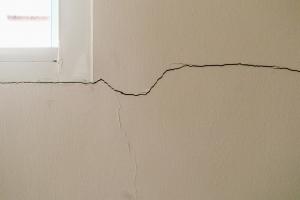
Signs Foundation Repair is Needed: How to Identify Common Warning Signs
Travis Hartley, Project Manager at Cable Lock Foundation Repair in Louisiana, explains that foundation issues can manifest in different ways, often starting with subtle changes that become more pronounced over time. "Foundation problems tend to worsen if not addressed early, which is why it's important for property owners to be vigilant and proactive about identifying warning signs," Hartley says. "By noticing these early indicators, homeowners can prevent serious damage that could compromise the safety and stability of their property."
1. Cracks in Walls and Floors
One of the most common signs of foundation problems is the appearance of cracks in the walls or floors. These cracks may start small but can expand over time as the foundation shifts. Cracks in drywall, especially around windows and doors, are red flags that the foundation may be experiencing movement. Similarly, cracks in floors, particularly if they are wide or uneven, can indicate that the foundation has settled or shifted in one or more areas.
Hartley notes, "Cracks in the interior of a home are often among the first signs of foundation problems. These cracks typically begin as small, hairline fractures and can gradually become wider as the foundation moves. It’s essential to monitor these cracks closely and seek professional advice if they worsen."
2. Uneven or Sloping Floors
Another common warning sign of foundation trouble is uneven or sloping floors. If the floor feels unlevel or if you notice that furniture or objects roll or shift on their own, it may indicate that the foundation has settled or shifted. In more extreme cases, parts of the floor may feel bouncy or spongy, which could suggest that the foundation is no longer providing proper support.
"When floors are no longer level, it’s a clear indication that something is off with the foundation," Hartley explains. "A floor that slopes or feels soft can mean that the foundation is sinking or shifting in certain areas, putting additional stress on the building."
3. Doors and Windows That Stick or Won’t Close Properly
When a foundation begins to shift, it can also affect the alignment of doors and windows. You may notice that doors become difficult to open or close, or that windows are misaligned and won’t shut properly. This is often due to the building settling unevenly, causing the door and window frames to shift out of alignment.
"One of the easiest ways to spot potential foundation problems is by noticing issues with doors and windows," says Hartley. "If doors or windows start sticking or become misaligned, it could be a sign that the foundation has moved. It’s important to address this issue quickly before it causes further complications."
4. Gaps Around Doors, Windows, or Exterior Walls
Another sign of foundation issues is the appearance of gaps between the exterior of the building and the surrounding frame. If there are noticeable gaps around doors or windows, or if you observe spaces between the walls and the ceiling or floor, these gaps can indicate that the foundation is no longer holding the structure in place.
"Often, the gaps around doors and windows are subtle at first, but they can become more pronounced over time," Hartley adds. "These gaps are a warning sign that the foundation may be experiencing significant movement, and they should not be ignored."
5. Exterior Cracks in the Foundation or Brickwork
Cracks in the exterior of a building, particularly in the foundation or brickwork, are another clear indication of potential foundation issues. Vertical cracks in the foundation may appear as the soil beneath the structure shifts, causing the foundation to crack under the pressure. Horizontal cracks, on the other hand, may be more serious and could indicate that the foundation is buckling under external pressure, such as excessive moisture or expansive soil.
"Cracks in the foundation or brick exterior should never be overlooked," says Hartley. "These cracks are an indication that the foundation is under stress and may require immediate attention to prevent further damage. If these cracks are left unaddressed, they can worsen and affect the overall stability of the building."
6. Pooling Water Around the Foundation
Excessive moisture around the foundation can contribute to shifting or settling, particularly if there are drainage issues or improper grading around the property. Water pooling near the foundation can weaken the soil, leading to erosion and further shifting of the structure. If the property experiences frequent flooding or if water consistently accumulates around the foundation, it could be a sign of serious underlying issues.
"Water damage and improper drainage are major contributors to foundation problems in Louisiana, where rainfall and flooding are common," Hartley explains. "When water accumulates around the foundation, it can erode the soil and weaken the foundation, causing it to shift or sink. Proper drainage and grading are essential in preventing water-related foundation problems."
7. Visible Shifting in the Exterior Landscape
Sometimes, foundation issues can manifest in the surrounding landscape. If you notice areas of the yard sinking, or if retaining walls begin to tilt, it could be a sign that the foundation is experiencing movement. Additionally, cracks in the driveway or sidewalks may appear as the foundation shifts and settles beneath them.
"Shifting in the landscape often occurs as the foundation settles unevenly, causing parts of the yard, driveway, or sidewalk to sink or shift," says Hartley. "These visible signs in the exterior landscape are indicators that the foundation may be in trouble and needs to be evaluated by a professional."
Conclusion
Foundation problems can be expensive and challenging to repair if left unchecked, but recognizing the warning signs early can help prevent major structural issues and costly repairs. By staying vigilant and addressing any signs of foundation distress as soon as they appear, property owners can protect their investment and maintain the safety and stability of their building.
For those in Louisiana, where soil movement and weather-related factors can impact foundation stability, it is essential to monitor for these warning signs regularly. Seeking professional help at the first sign of trouble can save both time and money in the long run, ensuring that the foundation remains secure and the property remains safe.
Morgan Thomas
Rhino Digital, LLC
+1 504-875-5036
email us here
Visit us on social media:
Facebook
Distribution channels: Building & Construction Industry, Culture, Society & Lifestyle, Real Estate & Property Management
Legal Disclaimer:
EIN Presswire provides this news content "as is" without warranty of any kind. We do not accept any responsibility or liability for the accuracy, content, images, videos, licenses, completeness, legality, or reliability of the information contained in this article. If you have any complaints or copyright issues related to this article, kindly contact the author above.
Submit your press release

